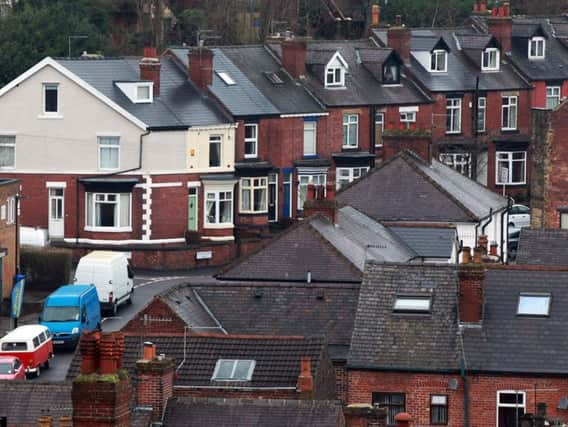Experts say building thousands of new homes should be a priority for Yorkshire


More homes, particularly in rural areas, would help keep communities together, stop talented young people leaving the region and boost Yorkshire’s economy, they said.
Advertisement
Hide AdAdvertisement
Hide AdHousing in Yorkshire is deeply underfunded as official figures show only 581 social homes were built in Yorkshire in the last financial year, despite waiting lists topping hundreds of thousands of people.
The Chartered Institute of Housing said Yorkshire needs more than three times that amount every year, to keep up with demand.
Chief executive Terrie Alafat said: “What Yorkshire needs from the next government is more homes, of the type people want, where they want them, and at a price they can afford. We believe that means a lot more homes at the lowest social rents, and that’s why we’re calling on any government to commit to a ten-year plan to build around 140,000 houses a year, including 90,000 at social rents.”
She said the organisation’s research showed people in Yorkshire on benefits were struggling to afford their rent.
Advertisement
Hide AdAdvertisement
Hide Ad“If you’re looking for a one-bedroom in Barnsley, a two or three-bed in Sheffield or shared accommodation in Leeds, Rotherham or Scarborough, 85 per cent or more of the available rentals aren’t covered by the housing part of your benefit.
“That leaves thousands of families all over Yorkshire facing a choice every week of paying their rent or spending money on food or heating. We don’t believe that’s acceptable. Those benefits should be restored to what they were in 2012, to cover 30 per cent of rents, taking into account local housing costs.”
Also in news: The ten questions The Yorkshire Post is asking the leaders of Britain's four largest political parties
James Prestwich, head of policy at the National Housing Federation said: “Our research shows we need to build 1,800 new social homes in Yorkshire and Humber each year to meet demand, over three times the number built last year. This must be part of a vital national programme of affordable house building. The next government must investment £12.8bn each year for the next ten years to deliver the homes needed across the country.”
Advertisement
Hide AdAdvertisement
Hide AdCarol Matthews, chair of Homes for the North, which represents housing associations in Yorkshire and across the north of England, agreed, adding the region needed to see “transformational” plans from the next government to help close the north-south divide.
“Homes for the North research shows that we need two million new homes in the north by 2050 in order to fulfil the promise of the Northern Powerhouse and rebalance the UK economy, a substantial proportion of which need to be genuinely affordable for those with low incomes.
“This will include a mix of social and market housing, and needs to be backed up by a growing share of public housing investment for the North.”
Rural areas have faced shrinking communities as young parents have struggled to buy property and raise their families in the villages they grew up in.
Advertisement
Hide AdAdvertisement
Hide AdThe next government needs to “help the countryside thrive”, according to Crispin Truman, chief executive of rural charity CPRE.
“Across our countryside, bus drivers, teachers and nurses – the people we need to keep rural areas running, and their families – are too often priced out of this opportunity.
“Investment in homes that meet genuine community needs, and relating the affordability of new homes more clearly to average incomes, are a clear step in the right direction.”
While government investment in homebuilding was a priority, private renters needed to be better protected too, as one in four families in Britain rent privately.
Advertisement
Hide AdAdvertisement
Hide AdCaitlin Wilkinson, policy manager at Generation Rent said: “Capping rents will go some way towards ensuring that renting is genuinely affordable for those on low incomes, but over the long term we need measures to sustainably bring rents down to around 30 per cent of median local incomes.”
Also in news: Bogus charity workers 'blew kisses' at elderly victims after stealing jewellery and cash from their homes in YorkshireBelow are the main parties’ pledges on housing, made in the run-up to the election:
Labour is promising to
- Scale up council house building to build 100,000 council homes a year by the end of the parliament, a more than 3,500 per cent increase
- Build at least 50,000 additional genuinely affordable homes a year through Housing Associations by the end of the parliament
Advertisement
Hide AdAdvertisement
Hide Ad- Scrap the Government’s definition of “affordable” which can be set at up to 80 per cent of market rents, and link it to incomes instead
- Give councils the powers and funding to buy back homes from private landlords
- End leasehold for the millions who have bought their home but don’t feel like they own it and abolish unfair terms and conditions
- New minimum standards for rented property, enforced through nationwide licensing and tougher sanctions for landlords who flout the rules
- Fund new renters’ unions and stop “no fault” evictions
The Conservative Party said it would
- Increase stamp duty by 3 per cent for non-UK residents
- Build a million homes over the next five years
Advertisement
Hide AdAdvertisement
Hide Ad- A new mortgage with long-term fixed rates, requiring only a 5 per cent deposit, to help renters buy their first homes
- A “First Home” scheme, which will sell properties at a 30 per cent discount to first time buyers
The Lib Dems promised
- Three-year tenancies, mandatory landlord licensing, tenancy deposit loans for young first-time renters
- Build 300,000 new homes each year, including 100,000 social homes
- Under-30s struggling to afford a deposit given access to government-backed loans